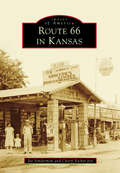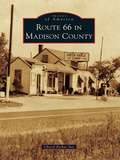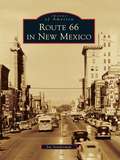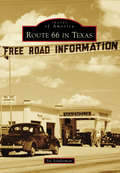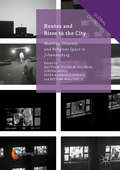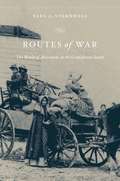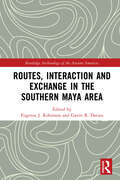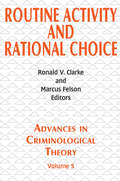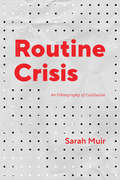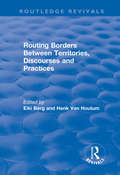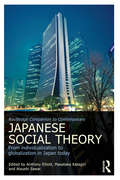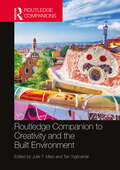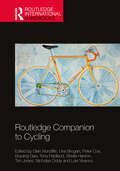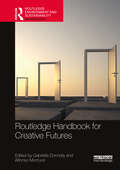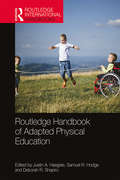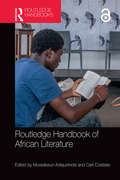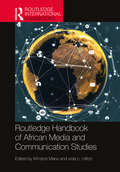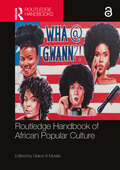- Table View
- List View
Route 66 in Kansas (Images of America)
by Joe Sonderman Cheryl Eichar JettThere are only 13.2 miles of Route 66 in Kansas, but the Sunflower State packs in as much history and adventure per mile as any of the eight Route 66 states. Route 66 in Kansas includes the wild tales from the days of "Red Hot Street" and the "First Cowtown in Texas." Blood was spilled here during the Civil War and when workers in the mines fought for their rights. Travelers will meet a beloved character from the motion picture Cars, cross a rare Rainbow Bridge, and see classic scenes along the Main Streets. Kansas was completely bypassed and was not even mentioned in the Bobby Troup song "(Get Your Kicks) on Route 66," but it would be a major mistake to pass it by today. It deserves to be experienced slowly--with the top down and the radio up.
Route 66 in Madison County
by Cheryl Eichar JettRoute 66 zigzagged southwest across Madison County, Illinois, before crossing the Mississippi River into Missouri. Various alignments of this segment of the "Mother Road" rolled through pastoral farmland, headed down main streets, and later straightened as it bypassed towns. From 1926 to 1977, the path of the highway changed numerous times and crossed the Mississippi River on no less than five different bridges. Along the way motorists watched for the blue neon cross on St. Paul's Lutheran Church to guide their nighttime travel; they counted on the doors of the Tourist Haven, Cathcart's, or the Luna Café to be open for business. Travelers crossed their fingers that they wouldn't get stuck at the bend of the Chain of Rocks Bridge and hoped they could make it up Mooney Hill in the winter. A later alignment took motorists right by Fairmount Park and Monks Mound.
Route 66 in New Mexico
by Joe SondermanNew Mexico is "The Land of Enchantment," offering a fascinating blend of Native American, Spanish Colonial, and Western American cultures. The travelers from the East knew they had arrived in the great Southwest when they entered New Mexico--the towns along Route 66 were ablaze in neon, and the motels lured travelers with Western themes, Pueblo Revival architecture, and Native American trading posts. An adventure still awaits the traveler today who takes the time to exit I-40 and leave the franchised blandness behind. The neon still flickers at the Blue Swallow Motel in Tucumcari, on Central Avenue in Albuquerque, and at the El Rancho Hotel in Gallup. The "Fat Man" still smiles at Joseph's Bar and Grill in Santa Rosa. The stories behind those landmarks are here, as well as the stories behind establishments that are lost forever or slowly crumbling to dust among the tumbleweeds.
Route 66 in Springfield
by Cheryl JettFrom 1926 through 1977, Route 66 carried millions of travelers from the shores of Lake Michigan to the Pacific Coast. Americans fell in love with the automobile and made a family tradition of the road trip. On its three different alignments through the capital city of Springfield, Route 66 took motorists around the Illinois State Fairgrounds, past the state capitol, and through Abraham Lincoln's neighborhood. Mom-and-pop motels, gas stations, and eateries opened along the highway and became familiar landmarks to travelers in the "Land of Lincoln." In Springfield, the "horseshoe" and the "cozy dog" became popular local foods, and one of the first drive-up window restaurants opened. A man spent 40 years on Route 66 operating his gas station before transforming it into an internationally known museum. Meet the proprietors of these businesses, witness the growth of the highway, and enjoy a generous dose of nostalgia.
Route 66 in Texas
by Joe SondermanRoute 66 stretches across 178 miles and through seven counties in the Texas Panhandle. To a traveler on Interstate 40, the road may seem like an endless expanse, with the horizon interrupted only by the occasional grain elevator. But there is history, scenery, and adventure waiting on Route 66, which follows the trail of the Native Americans, conquistadors, cattle and oil barons, cowboys, and Dust Bowl refugees. With such sites as the blazing neon sign at Shamrock's U-Drop Inn and the quiet ruins of Glenrio, Route 66 in Texas is still "The Main Street of America." The traveler who leaves the franchised blandness of the interstate will see motels with Western and Native American imagery, good old-fashioned tourist traps, some bizarre sculptures (such as cars stuck in the ground at Cadillac Ranch), and beautiful Art Deco structures. These images and stories tell of mom-and-pop establishments that still thrive today and those that are crumbling in the swirling dust and tumbleweeds of the notorious Jericho Gap.
Routeing Democracy in the Himalayas: Experiments and Experiences
by Vibha Arora; N. JayaramHistorically treated as an amorphous borderland and marginal to the understanding of democratic politics and governance in South Asia, Southeast Asia and northern Asia, the Himalayan region, in the last 50 years, has become an ‘active political laboratory’ for experiments in democratic structures and institutions. In turn, it has witnessed the evolution of myriad political ideologies, movements and administrative strategies to accommodate and pacify heterogeneous ethnic-national identities.Routeing Democracy in the Himalayas highlights how, through an ongoing process of democratisation, the Western liberal ideologies of democracy and decentralisation have interacted with varied indigenous politico-cultural ideas and institutions of an ethnic-nationally diverse population. It also reviews how formal democracy, regular elections, local self-governing structures, protection of the rights of minorities and indigenes, freedom of expression, development of mass media and formation of ethnic homelands — all have furthered participatory democracy, empowered the traditionally marginalised groups and ensured sustainable development to varying degrees. The book provides ethnographic and historical vistas of democracy under formation, at work, being contested and even being undermined, showing how democratisation thematically stitches the independent Himalayan nations and the Indian Himalayan states into a distinctive regional political mosaic.Combining new perspectives from comparative sociology, political anthropology and development studies, the volume will be useful for policy makers, as well as specialists, researchers and students in sociology, anthropology, area studies, development studies, and Tibet and Himalayan studies.
Routes and Rites to the City
by Lorena Núñez Matthew Wilhelm-Solomon Peter Kankonde Bukasa Bettina MalcomessThis thought-provoking book is an exploration of the ways religion and diverse forms of mobility have shaped post-apartheid Johannesburg, South Africa. It analyses transnational and local migration in contemporary and historical perspective, along with movements of commodities, ideas, sounds and colours within the city. It re-theorizes urban 'super-diversity' as a plurality of religious, ethnic, national and racial groups but also as the diverse processes through which religion produces urban space. The authors argue that while religion facilitates movement, belonging and aspiration in the city, it is complicit in establishing new forms of enclosure, moral order and spatial and gendered control. Multi-authored and interdisciplinary, this edited collection deals with a wide variety of sites and religions, including Christianity, Islam, Hinduism and Judaism. Its original reading of post-apartheid Johannesburg advances global debates around religion, urbanization, migration and diversity, and will appeal to students and scholars working in these fields.
Routes of War
by Yael A. SternhellThe Civil War thrust millions of men and women-rich and poor, soldiers and civilians, enslaved and free-onto the roads of the South. During four years of war, Southerners lived on the move. In the hands of Yael A. Sternhell, movement becomes a radically new means to perceive the full trajectory of the Confederacys rise, struggle, and ultimate defeat. By focusing not only on the battlefield and the home front but also on the roads and woods that connected the two, this pioneering book investigates the many roles of bodies in motion. We watch battalions of young men as they march to the front, galvanizing small towns along the way, creating the Confederate nation in the process. We follow deserters straggling home and refugees fleeing enemy occupation, both hoping to escape the burdens of war. And in a landscape turned upside down, we see slaves running toward freedom, whether hundreds of miles away or just beyond the plantations gate. Based on a vast array of documents, from slave testimonies to the papers of Confederate bureaucrats to the private letters of travelers from all walks of life, Sternhell unearths the hidden connections between physical movements and their symbolic meanings, individual bodies and entire armies, the reinvention of a social order and the remaking of private lives. Movement, as means of liberation and as vehicle of subjugation, lay at the heart of the human condition in the wartime South.
Routes, Interaction and Exchange in the Southern Maya Area (Routledge Archaeology of the Ancient Americas)
by Eugenia J. Robinson Gavin R. DaviesThis book explores routes of interaction and exchange in the Southern Maya Area, a zone that had both short- and long-distance trade and whose natural resources were exploited by merchants and rulers, colonists and entrepreneurs during Olmec, Teotihuacan, Maya, Aztec, colonial and modern times. The book presents the research of both archaeologists and art historians to identify routes of interconnection, to demonstrate the strategic importance of settlements and ritual locations, and to assess the significance of modes and mediums of exchange. The contributors employ innovative approaches, making use of state-of-the art technologies to reproduce and analyze the archaeological landscape (e.g. LiDAR, GIS, and least-cost path analysis) and to source and characterize archaeological materials (e.g. neutron activation analysis (NAA), X-ray fluorescence analysis [XRF] and strontium analysis). The book combines these innovative approaches with earlier data sources and past analyses to develop a new, synthetic analysis of interaction. Routes, Interaction and Exchange in the Southern Maya Area will appeal to professional academics, students, and interested lay readers from a broad range of social science fields including anthropology, archaeology, geography, economics, history, and art history and is appropriate for undergraduate and graduate courses in Mesoamerican archaeology.
Routes, Interaction and Exchange in the Southern Maya Area (Routledge Archaeology of the Ancient Americas)
by Eugenia J. Robinson Gavin R. DaviesThis book explores routes of interaction and exchange in the Southern Maya Area, a zone that had both short- and long-distance trade and whose natural resources were exploited by merchants and rulers, colonists and entrepreneurs during Olmec, Teotihuacan, Maya, Aztec, colonial and modern times.The book presents the research of both archaeologists and art historians to identify routes of interconnection, to demonstrate the strategic importance of settlements and ritual locations, and to assess the significance of modes and mediums of exchange. The contributors employ innovative approaches, making use of state-of-the art technologies to reproduce and analyze the archaeological landscape (e.g. LiDAR, GIS, and least-cost path analysis) and to source and characterize archaeological materials (e.g. neutron activation analysis (NAA), X-ray fluorescence analysis [XRF] and strontium analysis). The book combines these innovative approaches with earlier data sources and past analyses to develop a new, synthetic analysis of interaction.Routes, Interaction and Exchange in the Southern Maya Area will appeal to professional academics, students, and interested lay readers from a broad range of social science fields including anthropology, archaeology, geography, economics, history, and art history and is appropriate for undergraduate and graduate courses in Mesoamerican archaeology.
Routes: Travel and Translation in the Late Twentieth Century
by James CliffordWhen culture makes itself at home in motion, where does an anthropologist stand? In a follow-up to The Predicament of Culture, one of the defining books for anthropology in the last decade, James Clifford takes the proper measure: a moving picture of a world that doesn’t stand still, that reveals itself en route, in the airport lounge and the parking lot as much as in the marketplace and the museum. In this collage of essays, meditations, poems, and travel reports, Clifford takes travel and its difficult companion, translation, as openings into a complex modernity. He contemplates a world ever more connected yet not homogeneous, a global history proceeding from the fraught legacies of exploration, colonization, capitalist expansion, immigration, labor mobility, and tourism. Ranging from Highland New Guinea to northern California, from Vancouver to London, he probes current approaches to the interpretation and display of non-Western arts and cultures. Wherever people and things cross paths and where institutional forces work to discipline unruly encounters, Clifford’s concern is with struggles to displace stereotypes, to recognize divergent histories, to sustain “postcolonial” and “tribal” identities in contexts of domination and globalization. Travel, diaspora, border crossing, self-location, the making of homes away from home: these are transcultural predicaments for the late twentieth century. The map that might account for them, the history of an entangled modernity, emerges here as an unfinished series of paths and negotiations, leading in many directions while returning again and again to the struggles and arts of cultural encounter, the impossible, inescapable tasks of translation.
Routine Activity and Rational Choice: Volume 5 (Advances in Criminological Theory)
by Ronald V. Clarke Marcus FelsonTwo new criminological approaches are defined and applied to categories of crime in Routine Activity and Rational Choice, now available in paperback. Routine activity analyzes the criminal event, and avoids motivations and psychology as topics for discussion, whereas rational choice approaches crime as purposive behavior designed to meet the offender's commonplace needs, such as money, status, sex, and excitement. These conceptual models are both employed to analyze such crimes as drunk driving, gun use, kidnapping, and political violence. This volume discusses the relationship of these theories to more traditional approaches to crime studies.The Advances in Criminological Theory series encourages theory construction and validation in the articles and themes selected for publication. It also furthers the free exchange of ideas, propositions, and postulates. Following publication of the first volume, Michael J. Lynch of Florida State University asserted that "Advances in Criminological Theory is to be applauded as an attempt to revive criminological theory by providing an accessible outlet." Contributions to this volume include: Pierre Tremblay, "Searching for Suitable Co-offenders"; Raymond Paternoster and Sally Simpson, "A Rational Choice Theory of Corporate Crime"; Richard B. Felson, "Predatory and Dispute-related Violence"; Gordon Trasler, "Conscience, Opportunity, Rational Choice, and Crime"; Ezzat A. Fattah, "The Rational Choice/Opportunity Perspectives as a Vehicle for Integrating Criminological and Victimological Theories"; Patricia L. Brantingham and Paul J. Brantingham, "Environment, Routine, and Situation"; Maurice Cusson, "A Strategic Analysis of Crime"; Richard W. Harding, "Gun Use in Crime, Rational Choice, and Social Learning Theory."
Routine Crisis: An Ethnography of Disillusion (Chicago Studies in Practices of Meaning)
by Sarah MuirArgentina, once heralded as the future of capitalist progress, has a long history of economic volatility. In 2001–2002, a financial crisis led to its worst economic collapse, precipitating a dramatic currency devaluation, the largest sovereign default in world history, and the flight of foreign capital. Protests and street blockades punctuated a moment of profound political uncertainty, epitomized by the rapid succession of five presidents in four months. Since then, Argentina has fought economic fires on every front, from inflation to the cost of utilities and depressed industrial output. When things clearly aren't working, when the constant churning of booms and busts makes life almost unlivable, how does our deeply compromised order come to seem so inescapable? How does critique come to seem so blunt, even as crisis after crisis appears on the horizon? What are the lived effects of that sense of inescapability? Anthropologist Sarah Muir offers a cogent meditation on the limits of critique at this historical moment, drawing on deep experience in Argentina but reflecting on a truly global condition. If we feel things are being upended in a manner that is ongoing, tumultuous, and harmful, what would we need to do—and what would we need to give up—to usher in a revitalized critique for today's world? Routine Crisis is an original provocation and a challenge to think beyond the limits of exhaustion and reimagine a form of criticism for the twenty-first century.
Routine Crisis: An Ethnography of Disillusion (Chicago Studies in Practices of Meaning)
by Sarah MuirArgentina, once heralded as the future of capitalist progress, has a long history of economic volatility. In 2001–2002, a financial crisis led to its worst economic collapse, precipitating a dramatic currency devaluation, the largest sovereign default in world history, and the flight of foreign capital. Protests and street blockades punctuated a moment of profound political uncertainty, epitomized by the rapid succession of five presidents in four months. Since then, Argentina has fought economic fires on every front, from inflation to the cost of utilities and depressed industrial output. When things clearly aren't working, when the constant churning of booms and busts makes life almost unlivable, how does our deeply compromised order come to seem so inescapable? How does critique come to seem so blunt, even as crisis after crisis appears on the horizon? What are the lived effects of that sense of inescapability? Anthropologist Sarah Muir offers a cogent meditation on the limits of critique at this historical moment, drawing on deep experience in Argentina but reflecting on a truly global condition. If we feel things are being upended in a manner that is ongoing, tumultuous, and harmful, what would we need to do—and what would we need to give up—to usher in a revitalized critique for today's world? Routine Crisis is an original provocation and a challenge to think beyond the limits of exhaustion and reimagine a form of criticism for the twenty-first century.
Routine Crisis: An Ethnography of Disillusion (Chicago Studies in Practices of Meaning)
by Sarah MuirArgentina, once heralded as the future of capitalist progress, has a long history of economic volatility. In 2001–2002, a financial crisis led to its worst economic collapse, precipitating a dramatic currency devaluation, the largest sovereign default in world history, and the flight of foreign capital. Protests and street blockades punctuated a moment of profound political uncertainty, epitomized by the rapid succession of five presidents in four months. Since then, Argentina has fought economic fires on every front, from inflation to the cost of utilities and depressed industrial output. When things clearly aren't working, when the constant churning of booms and busts makes life almost unlivable, how does our deeply compromised order come to seem so inescapable? How does critique come to seem so blunt, even as crisis after crisis appears on the horizon? What are the lived effects of that sense of inescapability? Anthropologist Sarah Muir offers a cogent meditation on the limits of critique at this historical moment, drawing on deep experience in Argentina but reflecting on a truly global condition. If we feel things are being upended in a manner that is ongoing, tumultuous, and harmful, what would we need to do—and what would we need to give up—to usher in a revitalized critique for today's world? Routine Crisis is an original provocation and a challenge to think beyond the limits of exhaustion and reimagine a form of criticism for the twenty-first century.
Routing Borders Between Territories, Discourses and Practices (Critical Security Ser.)
by Eiki Berg Henk Van HoutumThis title was first published in 2003. This multi-disciplinary reading focuses on the latent meaningful and contextual strategies that are often implied and included in bordering processes. It demonstrates that the border as a concept is not so much an object, but rather an ongoing process. The book also consciously and provocatively balances the modernist trap of universalism, exclusive ordering and state-centrism and the postmodernist trap of moral nihilism. Leading specialists in their fields provide illustrative case studies from Europe and Asia, making a major contribution to border studies.
Routledge Companion to Contemporary Japanese Social Theory: From Individualization to Globalization in Japan Today (Routledge Advances in Sociology)
by Anthony Elliott Masataka Katagiri Atsushi SawaiThe Routledge Companion to Contemporary Japanese Social Theory breaks new ground in providing a detailed, systematic appraisal of the major traditions of social theory prominent in Japan today – from theories of identity and individualization to globalization studies. The volume introduces readers to the rich diversity of social-theoretical critique in contemporary Japanese social theory. The editors have brought together some of the most influential Japanese social scientists to assess current trends in Japanese social theory, including Kazuhisa Nishihara, Aiko Kashimura, Masahiro Ogino, Yumiko Ehara and Kiyomitsu Yui. The volume also contains dialogues with these Japanese contributors from authoritative Western social theorists – including, among others, Axel Honneth, Roland Robertson, Bryan S. Turner, Charles Lemert and Anthony Elliott – to reflect on such developments. The result is an exciting, powerful set of intellectual exchanges. The book introduces, contextualizes and critiques social theories in the broader context of Japanese society, culture and politics – with particular emphasis upon Japanese engagements and revisions of major traditions of social thought. Divided into two sections, the book surveys traditions of social thought in Japanese social science and presents the major social issues facing contemporary Japan. The book will appeal to students and scholars of sociology, social theory, critical theory, psychoanalysis, risk, gender studies, feminist studies, self and identity studies, media studies and cultural studies.
Routledge Companion to Creativity and the Built Environment (Routledge International Handbooks)
by Tan Yigitcanlar Julie T. MiaoThis book crtitically examines the reciprocal relationship between creativity and the built environment and features leading voices from across the world in a debate on originating, learning, modifying, and plagiarizing creativities within the built environment.The Companion includes contributions from architecture, design, planning, construction, real estate, economics, urban studies, geography, sociology, and public policies. Contributors review the current field and proposes new conceptual frameworks, research methodologies, and directions for research, policy, and practice. Chapters are organised into five sections, each drawing on cross-disciplinary insights and debates: Section I connects creativity, productivity, and economic growth and examines how our built environment stimulates or intimidates human imaginations. Section II addresses how hard environments are fabricated with social, cultural, and institutional meanings, and how these evolve in different times and settings. Section III discusses activities that directly and indirectly shape the material development of a built environment, its environmental sustainability, space utility, and place identity. Section IV illustrates how technologies and innovations are used in building and strengthening an intelligent, real-time, responsive urban agenda. Section V examines governance opportunities and challenges at the interface between creativity and built environment. An important resource for scholars and students in the fields of urban planning and development, urban studies, environmental sustainability, human geography, sociology, and public policy.
Routledge Companion to Cycling (Routledge International Handbooks)
by Tim Jones Peter Cox Glen Norcliffe Tony Hadland Luis Vivanco Una Brogan Boyang Gao Sheila Hanlon Nicholas OddyRoutledge Companion to Cycling presents a comprehensive overview of an artefact that throughout the modern era has been a bellwether indicator of the major social, economic and environmental trends that have permeated society The volume synthesizes a rapidly growing body of research on the bicycle, its past and present uses, its technological evolution, its use in diverse geographical settings, its aesthetics and its deployment in art and literature. From its origins in early modern carriage technology in Germany, it has generated what is now a vast, multi-disciplinary literature encompassing a wide range of issues in countries throughout the world.
Routledge Companion to the Israeli-Palestinian Conflict
by Asaf SiniverThis Companion explores the Israeli-Palestinian conflict from its inception to the present day, demonstrating the depth and breadth of the many facets of the conflict, from the historical, political, and diplomatic to the social, economic, and pedagogical aspects. The contributions also engage with notions of objectivity and bias and the difficulties this causes when studying the conflict, in order to reflect the diversity of views and often contentious discussion surrounding this conflict. The volume is organized around six parts, reflecting the core aspects of the conflict: • historical and scholarly context of the competing narratives • contemporary evolution of the conflict and its key diplomatic junctures • key issues of the conflict • its local dimensions • international environment of the conflict • the "other images" of the conflict, as reflected in public opinion, popular culture, the boycott, divestment and sanctions (BDS) movement, and academia and pedagogy. Providing a comprehensive approach to the Israeli-Palestinian conflict, this companion is designed for academics, researchers, and students interested in the key issues and contemporary themes of the conflict.
Routledge Handbook for Creative Futures (Routledge Environment and Sustainability Handbooks)
by Gabrielle Donnelly Alfonso MontuoriAs the uncertainty of global and local contexts continues to amplify, the Routledge Handbook for Creative Futures responds to the increasing urgency for reimagining futures beyond dystopias and utopias. It features essays that explore the challenges of how to think about compelling futures, what these better futures might be like, and what personal and collective practices are emerging that support the creation of more desirable futures. The handbook aims to find a sweet spot somewhere between despair and naïve optimism, neither shying away from the massive socio-environmental planetary challenges currently facing humanity nor offering simplistic feel-good solutions. Instead, it offers ways forward—whether entirely new perspectives or Indigenous and Traditional Knowledge perspectives that have been marginalized within modernity—and shares potential transformative practices. The volume contains contributions from established and emerging scholars, practitioners, and scholar-practitioners with diverse backgrounds and experiences: a mix of Indigenous, Black, Asian, and White/Caucasian contributors, including women, men, and trans people from around the world, in places such as Kenya, India, US, Canada, and Switzerland, among many others. Chapters explore critical concepts alongside personal and collective practices for creating desirable futures at the individual, community, organizational, and societal levels. This scholarly and accessible book will be a valuable resource for researchers and students of leadership studies, social innovation, community and organizational development, policy studies, futures studies, cultural studies, sociology, and management studies. It will also appeal to educators, practitioners, professionals, and policymakers oriented toward activating creative potential for life-affirming futures for all.
Routledge Handbook of Adapted Physical Education (Routledge International Handbooks)
by Samuel R. Hodge Justin A. Haegele Deborah R. ShapiroThis handbook represents the first comprehensive and evidence-based review of theory, research, and practice in the field of adapted physical education (APE). Exploring philosophical and foundational aspects of APE, the book outlines the main conceptual frameworks informing research and teaching in this area, and presents important material that will help shape best practice and future research. Written by world-leading researchers, the book introduces the key themes in APE, such as historical perspectives on disability, disability and the law, language, and measurement. It examines the most significant theoretical frameworks for understanding APE, from embodiment and social cognitive theory to occupational socialization, and surveys current debates and practical issues in APE, such as teacher training, the use of technology, and physical inactivity and health. Acknowledging the importance of the voices of children, parents and peers, the book also explores research methods and paradigms in APE, with each chapter including directions for further research. Offering an unprecedented wealth of material, the Routledge Handbook of Adapted Physical Education is an essential reference for advanced students, researchers and scholars working in APE, and useful reading for anybody with an interest in disability, physical education, sports coaching, movement science or youth sport.
Routledge Handbook of African Literature
by Carli Coetzee Moradewun AdejunmobiThe turn of the twenty-first century has witnessed an expansion of critical approaches to African literature. The Routledge Handbook of African Literature is a one-stop publication bringing together studies of African literary texts that embody an array of newer approaches applied to a wide range of works. This includes frameworks derived from food studies, utopian studies, network theory, eco-criticism, and examinations of the human/animal interface alongside more familiar discussions of postcolonial politics. The handbook is divided into seven parts, i) Mapping political agencies ii) Journeys, geographies, identities iii) Working through genre iv) The world of and beyond humans v) Everyday sociality vi) Bodies, subjectivities, affect vii) Literary networks. In each, contributors address the themes of the section from a variety of perspectives in conjunction with analysis of different literary texts. Every chapter is an original research essay written by a broad spectrum of scholars with expertise in the subject, providing an application of the most recent insights into analysis of particular topics or application of particular critical frameworks to one or more African literary works. The handbook will be a valuable interdisciplinary resource for scholars and students of African literature, African culture, postcolonial literature and literary analysis.
Routledge Handbook of African Media and Communication Studies
by Winston Mano Viola C. MiltonThis handbook comprises fresh and incisive research focusing on African media, culture and communication. The chapters from a cross-section of scholars dissect the forces shaping the field within a changing African context. It adds critical corpora of African scholarship and theory that places the everyday worlds, needs and uses of Africans first. The book goes beyond critiques of the marginality of African approaches in media and communication studies to offer scholars the theoretical and empirical toolkit needed to start building critical corpora of African scholarship and theory that places the everyday worlds, needs and uses of Africans first. Decoloniality demands new epistemological interventions in African media, culture and communication, and this book is an important interlocutor in this space. In a globally interconnected world, changing patterns of authority and power pose new challenges to the ways in which media institutions are constituted and managed, as well as how communication and media policy is negotiated and the manner in which citizens engage with increasing media opportunities. The handbook focuses on the interrelationships of the local and the global and the concomitant consequences for media practice, education and citizen engagement in today’s Africa. Altogether, the book foregrounds convivial epistemologies relevant for locating African media and communication in the pluriverse. This handbook is an essential read for critical media, communications, cultural studies and journalism scholars.
Routledge Handbook of African Popular Culture
by Grace A MusilaThis handbook brings together an international team of scholars from different disciplines to reflect on African popular cultural imaginaries. These imaginaries – in the sense of cultural productions, contexts, consumers, producers, platforms, and the material, affective and discursive resources they circulate – are influential in shaping African realities. Collectively, the chapters assembled in this handbook index the genres, methods, mediums, questions and encounters that preoccupy producers, consumers and scholars of African popular cultural forms across a range of geohistorical and temporal contexts. Drawing on forms such as newspaper columns, televised English Premier League football, speculative arts, romance fiction, comedy, cinema, music and digital genres, the contributors explore the possibilities and ambiguities unleashed by the production, circulation, consumption, remediation and critique of these forms. Among the questions explored across these essays are the freedoms and constraints of popular genres; the forms of self-making, pleasure and harm that these imaginaries enable; the negotiations of multiple moral regimes in everyday life; and, inevitably, the fecund terrain of contradictions definitive of many popular forms, which variously enable and undermine world-making. An authoritative scholarly resource on popular culture in Africa, this handbook is an essential read for students and scholars of African culture, society and media.
